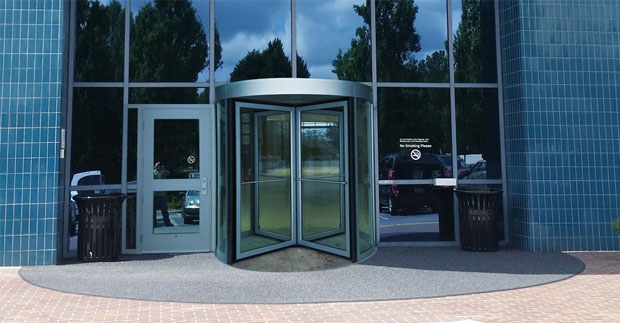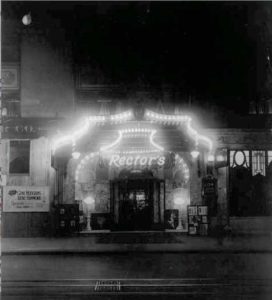There is a revolving door almost in any building in Chicago, IL. These doors are a funny and smooth way to enter a building. But besides that, nothing is interesting about them. Or is it? Actually, the history of the revolving door is a very interesting one. And it’s one that not all people know.
A revolving door typically consists of three or four doors that hang on a central shaft and rotate around a vertical axis.
These doors are commonly used in downtown areas. They are the perfect entrance for tall buildings and skyscrapers since revolving doors enhance their appearance.

Who Invented the Revolving Door?
Who invented the revolving door? That is a good question if you want to know about the origin of this particular type of door that, as we know it, elevates the appearance of any building in Chicago, IL.
Theophilus van Kannel invented the revolving door. He was granted the patent for the invention on August 7, 1888.
In the beginning, the invention’s name was “Storm-Door Structure.” This invention was originally a three-partition revolving door with weather strips.
The primary purpose of this invention was to prevent strong drafts of wind from entering a building when a door was opened.
So, the revolving door was designed to be energy-efficient. It worked to this day like an airlock. In other words, it prevents drafts of cold or hot air.
This invention helped reduce the amount of energy the HVAC system uses. By avoiding air drafts, there wasn’t a drastic temperature change when people entered or exited a building.
The revolving door was also invented because hinged doors didn’t work efficiently handling people’s traffic. Only one person can enter or exit at a time through some hinged doors.
While revolving doors can allow more people to enter and exit at the same time.
But there is another part of the story. Allegedly, Theophilus van Kannel invented the revolving door for another reason. Continue reading to find out.

The Interesting Part of The History of the Revolving Door!
What [Allegedly] Motivated The Invention of the Revolving Door?
In the late 1800s, Theophilus van Kannel supposedly designed a revolving door because he hated chivalry.
Nobody knows if this is a fact. So, allegedly, he didn’t like to argue with other men over who should enter or exit a door first. Even worse, he hated to open doors for women.
Legend says his hate towards chivalry was due to a childhood traumatic memory. Starting his teenage years, Kannel found chivalry standards annoying and uncalled for. In fact, many times, he felt obligated to keep up with them. Still, his mother took them very seriously, scolding him many times when he did not follow them.
One day, Kannel ignored his mother too much. This is when the spanking started. Kannel’s mother spanked twelve-year-old Kannel’s bare-bottomed. This happened in front of a crowd of women.
Kannel, from that moment on, changed forever. In Kannel’s mind, chivalry meant the pain he went through.
Again, there is no proof that this story is true. But surely, it is an interesting part of the history of the revolving door.
The Proven Facts of The History of the Revolving Door


A year after his patent, in 1889, Van Kannel received the John Scott Medal. This award showed Kannel’s contribution to society.
A decade later, the world witnessed its first revolving door. At that time, Rector’s was a popular and luxurious restaurant in Times Square, Manhattan. We all know how Times Square is always full of noise and distraction. Because of this, Rector’s hosted the first revolving door to the public in 1899.
The 1900s took a great part in the history of the revolving door. Corporations wanted a door that could be elegant and, at the same time, useful. They wanted revolving doors.
Kannel looked for ways to improve and refine his invention. Because of this, he founded the Kannel Revolving Door Company.
Our story’s protagonist ends in 1919, dying at the age of 78 on Christmas Eve. Van Kannel was a multi-talented and intelligent man. In 2007, the National Inventors Hall of Fame added Van Kannet to their list.
The history of the revolving door started almost a century ago. Still today, revolving doors mark our daily lives. They offer incredible advantages for businesses, so it’s no wonder companies love them.
THE VERSATILITY AND ADAPTABILITY OF THE REVOLVING DOOR
The revolving door – is an unassuming yet ingenious piece of architecture that has become a staple in any modern urban setting. But did you know that its origins can be traced back to a rural novelty on farms? Here’s a closer look at the fascinating history and evolution of the revolving door.
Dual-Purpose Design: As the design of the revolving door evolved, architects found ways to incorporate it into their building’s overall aesthetic. Today, they are available in various materials, colors, and finishes, making them a versatile and stylish addition to any building.
Adapting to New Technologies: The revolving door has also adapted to new technologies, including biometric scanners and automatic sensors. These additions enhance security and simplify access control, making them famous for hotels, airports, and other high-security locations.
Future Innovations: As we move towards a more sustainable future, architects are exploring further ways to innovate the revolving door’s design. One exciting development is the incorporation of wind turbines into the design, allowing the door to generate energy.
From its humble beginnings on rural farms to its status as an urban architectural staple, the revolving door has come a long way. Its unique design, energy efficiency, and safety benefits have made it an indispensable part of modern building design. As we continue to push the boundaries of architecture, it’s exciting to think about the future innovations for this timeless innovation.

